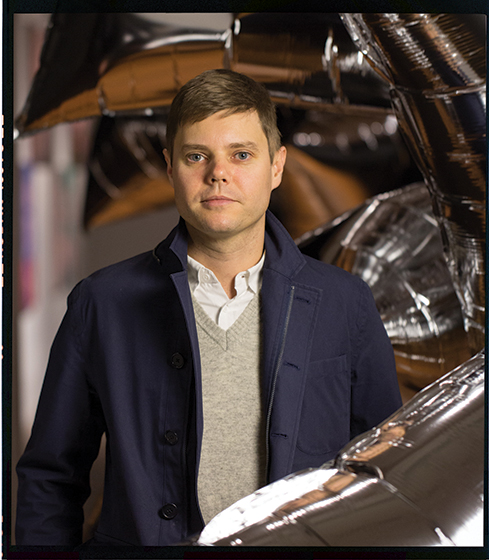 Spring 2014
Spring 2014|
Nicholas Chambers
Curator Nicholas Chambers vividly recalls his first brush with a real Warhol. It was 1990 and the 16-year-old Australian was visiting the States with his parents, who took him sightseeing to New York City and its Museum of Modern Art. “One of the things that really struck me was seeing large-scale, mid-century American paintings,” Chambers says. “It was the first time I really understood that art could be sensuous and about experience while also being a serious, intellectual pursuit.” He particularly remembers Warhol’s 1963 silkscreen, Orange Car Crash Fourteen Times. Fast forward to 2007, and Chambers is curator of international contemporary art at the Queensland Art Gallery - Gallery of Modern Art in Brisbane, collaborating with The Andy Warhol Museum on Australia’s first major Warhol retrospective. The Aussie spends a week in Pittsburgh, poring over the museum’s vast collection and archives. His tour guide for all things Warhol is the museum’s longtime chief archivist, Matt Wrbican. The two hit it off, and the exhibition of 300-plus works is a smash. Five years later, Wrbican calls Chambers with an interesting proposition: Would you ever consider moving to Pittsburgh? Museum Director Eric Shiner was looking for the museum’s next Milton Fine Curator of Art, and the staff had a good feeling about him. Today that staff is in the throes of a complete art rehang in honor of the museum’s 20thanniversary celebration in May, and Chambers, who discovered the power of Warhol almost by chance, is leading the charge. “People find a way to Warhol through all sorts of different avenues,” he notes. “Warhol is about multiplicity. The story of his life and work is forever unfolding.” What appealed to you most about coming to The Warhol?My interests as a curator lie both in long-range research projects and in faster, more responsive exhibition- making. It’s rare that one has the opportunity to do both but that’s exactly the situation at The Warhol. I enjoy collaborating with my colleagues and researchers around the world to bring new perspectives to bear on Warhol’s work, and it’s exciting and energizing to do this kind of work while also developing contemporary shows with living artists and being engaged with the local art scene. How is the museum going about the complete rehang of all its galleries?Over the years the interest in the collection has grown phenomenally, and as a result we are regularly sharing elements of our collection with other museums. This helps us to expand the discussion around Warhol and Pittsburgh but also has an effect on the works on display in Pittsburgh. The rehang will establish a series of templates that we can work within as we periodically rotate and refresh the galleries. The most important factor motivating the rehang, however, is a desire to tell the story of Warhol’s life and work in a more structured way. There’s no single, definitive story of Warhol; that’s something we’re very mindful of. There are so many different ways to talk about and interpret his work—different ways for thinking about who Warhol was and what he represented. Will it be a chronological approach?On the seventh floor we’ll start in the ‘20s and ‘30s, in Pittsburgh, and then visitors will move down through the museum, progressing in a chronological fashion. While chronology is certainly the overarching principle, there will be certain thematic focuses as well. For instance, we’re developing displays dedicated to his moving-image work, including a new system whereby visitors can select films and video to watch on demand. We’re also renovating the third floor and reopening part of that space so that we will again have a permanent location to display the Time Capsules and other archival materials. On the second floor we’ll have temporary exhibitions, and in May we’ll launch Halston and Warhol: Silver and Suede. What’s surprised you most about Warhol?Because we are always collaborating with people from different parts of the world—last year this included Italy, Azerbaijan, and China—people are always coming to us with surprising points of view and different lines of argument about Andy’s work. This is something Warhol was very aware of and even encouraged— different interpretations of his work, both within the art world and also beyond it in the broader sphere of popular culture. What’s most exciting about life at The Warhol?That we’re still making new discoveries. There are films and videos that have yet to be restored, there are still parts of the archives that are to be unpacked and cataloged. The story is still very much evolving, and that’s not something you can say about many artists who passed away in 1987.
|
Unraveling Race · Silver & Suede · The Tedious Intrigue of Art Conservation · Sun Struck · President's Note · NewsWorthy · Artistic License: The Science of Sculpture · Science & Nature: Nature as Classroom · About Town: Friends of the Forest · The Big Picture
 |
Copyright © 2017 CARNEGIE Magazine. All rights reserved. |

